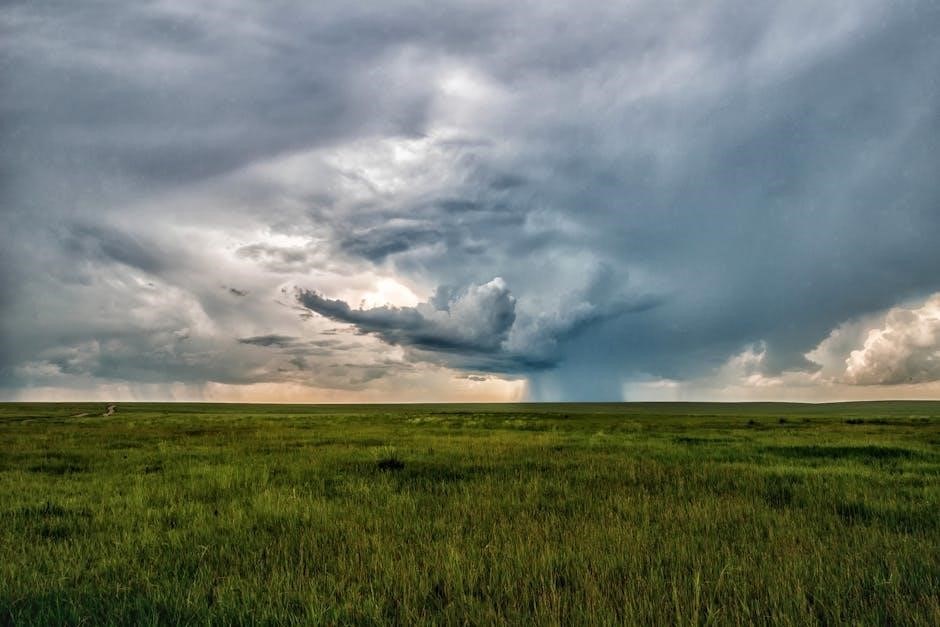
the storm kate chopin pdf
Kate Chopin’s The Storm is a provocative short story exploring themes of passion and societal constraints, available in PDF for easy reading and analysis of its timeless appeal.
1.1 Overview of the Short Story
Kate Chopin’s “The Storm” is a short story set in Louisiana, focusing on Calixta and Alcée rekindling their past during a tempest. Written in 1898, it explores themes of passion and societal constraints. Available in PDF, the story examines forbidden love, highlighting Chopin’s bold narrative style and enduring relevance.
1.2 Historical Context and Publication
Written in 1898, “The Storm” was initially suppressed due to its controversial themes of adultery and societal norms. Chopin chose not to publish it during her lifetime, fearing backlash. The story remained unpublished until 1969, when it gained recognition for its bold portrayal of passion and independence. Available in PDF, it offers insights into Chopin’s progressive views.
Biography of Kate Chopin
Kate Chopin, born in 1851, was a trailblazing American writer whose works, including The Storm, were published posthumously, gaining her lasting literary acclaim and recognition.
2.1 Early Life and Influences
Kate Chopin was born in 1851 in St. Louis, Missouri, to a French-Creole mother and an Irish father. Her father’s death in a tramway accident left her in a household of strong women, shaping her feminist perspectives. Educated in Catholic schools, Chopin was exposed to French and American cultures, influences reflected in her writing. Her marriage to Oscar Chopin and life in Louisiana further enriched her literary style and thematic focus.
2.2 Literary Career and Major Works
Kate Chopin began writing after her husband’s death, publishing short stories and novels. Her works, like The Awakening, explored women’s roles in society. The Storm, written in 1898, was initially unpublished due to its controversial themes but later became a celebrated piece, showcasing her bold exploration of passion and societal norms in PDF formats.
2.3 Death and Posthumous Recognition
Kate Chopin died at 52 from a brain hemorrhage. Her work, including The Storm, gained recognition posthumously. Once deemed controversial, her stories are now celebrated for their exploration of women’s roles and desires, with PDF versions widely available for study and appreciation of her literary legacy.

Plot Summary of “The Storm”
Kate Chopin’s The Storm follows Calixta and Alcée, former lovers, reuniting during a tempest. Their passionate encounter, set in 19th-century Louisiana, explores forbidden desire and societal norms, available in PDF for deeper exploration of its intricate narrative and themes.
3.1 Setting and Characters
The Storm unfolds in 19th-century Louisiana during a violent storm. Central characters include Calixta, a passionate woman; Alcée, her former lover; and her family, Bobinôt and Bibi. The tempestuous weather mirrors the characters’ turbulent emotions, while the PDF version provides a detailed exploration of this intricate setting and its impact on the narrative.
3.2 The Storm’s Impact on the Characters
The storm ignites suppressed desires and emotions in Calixta and Alcée, leading to a passionate encounter. It forces Bobinôt and Bibi to seek shelter, highlighting familial bonds. The PDF version delves into how the tempest mirrors internal conflicts, driving character development and emotional revelation, central to the story’s enduring themes of love and societal constraints.
3.3 Climax and Resolution
The storm’s climax occurs as Calixta and Alcée surrender to their passion, their encounter fueled by raw emotion. The resolution sees them part ways, each returning to their respective lives. The PDF versions of the story emphasize this emotional journey, highlighting the brief yet intense connection between the characters and societal expectations.

Themes in “The Storm”
Kate Chopin’s The Storm delves into themes of passion, societal expectations, and feminine independence, as seen in Calixta’s emotional conflict. The PDF highlights these elements, offering insight into Chopin’s exploration of human desire and the constraints of her era.
4.1 Passion vs. Societal Expectations
Kate Chopin’s The Storm explores the clash between personal passion and societal norms, as Calixta navigates her desire for Alcée amidst the constraints of her marriage. The PDF highlights how the story portrays the internal conflict of a woman torn between love and societal expectations, reflecting Chopin’s critique of rigid moral codes.
4.2 Feminine Sexuality and Independence
Kate Chopin’s The Storm delves into feminine sexuality and independence, portraying Calixta as a woman embracing her desires despite societal norms. The PDF explores how Chopin challenges traditional roles, highlighting Calixta’s autonomy and the tension between her personal freedom and the constraints imposed by her marriage and community expectations.
4.3 Nature as a Metaphor
In The Storm, Chopin uses nature as a metaphor for human emotions and societal tensions. The tempest mirrors Calixta’s inner turmoil and passion, while the calm afterward symbolizes resolution. The PDF highlights how Chopin employs natural elements like clouds and rain to reflect the characters’ emotional states and the broader societal constraints they navigate.

Character Analysis
In The Storm, Kate Chopin masterfully portrays Calixta and Alcée, whose forbidden passion ignites during a tempest, revealing their inner desires and societal pressures.
5.1 Calixta: The Protagonist
Calixta is the central figure in The Storm, embodying both strength and vulnerability. Her encounter with Alcée during the tempest reveals her suppressed desires, while her marriage to Bobinôt highlights her societal role. Chopin portrays her as a symbol of feminine sexuality and independence, trapped between passion and responsibility, making her a compelling protagonist in the story.
5.2 Alcée: The Lover
Alcée, a wealthy plantation owner and former lover of Calixta, is a central figure in the story. His encounter with Calixta during the storm reignites their past passion, showcasing his assertiveness and desire. Despite being married to Clarisse, Alcée embodies the tension between societal expectations and personal longing, highlighting Chopin’s exploration of forbidden love and individual desire.
5.3 Bobinôt and Bibi: The Family
Bobinôt and Bibi represent the stable family life contrasting Calixta’s passionate encounter. Bobinôt, a caring husband and father, shelters with Bibi at Friedheimer’s store during the storm, showcasing his protective nature. Their bond highlights domestic harmony, while Calixta’s tryst with Alcée unfolds, underscoring the tension between duty and desire in Chopin’s narrative.

Symbolism in “The Storm”
The storm symbolizes passion and turmoil, mirroring the characters’ emotions, while the house represents shelter and confinement, highlighting societal constraints on female sexuality and independence.
6.1 The Storm as a Symbol
The storm in Kate Chopin’s story serves as a powerful symbol, reflecting the intense emotions and societal conflicts of the characters. Its wild, uncontrollable nature mirrors the passion and turmoil between Calixta and Alcée, while also representing the societal constraints that surround them, creating a paradox of liberation and confinement in their brief encounter.
6.2 The House and Shelter
The house in The Storm symbolizes both safety and confinement. It provides refuge from the tempest outside but also traps Calixta and Alcée in a space where societal norms are momentarily suspended, allowing their suppressed desires to surface, highlighting the tension between protection and liberation in their forbidden encounter.
6.3 Time and Setting
The story unfolds in Louisiana during the late 19th century, with the storm serving as both a literal and metaphorical backdrop. The setting, a rural bayou, isolates characters, intensifying emotional tensions. Chopin’s vivid depiction of time and place immerses readers in the world of Calixta and Alcée, mirroring their internal conflicts with the external tempest.

Literary Style and Technique
Kate Chopin’s The Storm showcases her mastery of vivid imagery and concise narrative structure. Her writing style enhances the emotional intensity, creating a passionate and evocative tale.
7.1 Chopin’s Use of Language
Kate Chopin’s language in The Storm is rich and evocative, employing vivid descriptions and sensual metaphors. Her concise prose heightens the emotional tension, drawing readers into the intimate, charged atmosphere between Calixta and Alcée, mirroring the storm’s intensity and the characters’ forbidden passion.
7.2 Narrative Structure
Kate Chopin’s narrative structure in The Storm is concise and impactful, using the storm as a unifying element. The story unfolds in a single setting, intensifying the emotional and physical tension between Calixta and Alcée, while the storm outside mirrors their inner turmoil, creating a dramatic and intimate narrative flow.
7.3 Imagery and Description
Chopin’s vivid imagery in The Storm enriches the narrative, with descriptions of the tempestuous weather and Calixta’s emotional state. The storm’s intensity mirrors the characters’ passion, while details like the “sombre clouds” and “sullen, threatening roar” create a immersive atmosphere, drawing readers into the story’s charged environment.

Historical and Cultural Context
The Storm reflects late 19th-century Louisiana’s societal norms, exploring themes of passion and female sexuality within a rigid cultural framework, resonating with Chopin’s progressive views.
8.1 Louisiana in the Late 19th Century
Late 19th-century Louisiana was marked by cultural diversity and social change, with influences from French, Spanish, and African traditions. The region’s history of slavery, Reconstruction, and racial tensions shaped societal norms, providing a rich backdrop for Chopin’s exploration of gender roles and sexuality in The Storm.
8.2 Women’s Roles in Society
In late 19th-century Louisiana, women were often confined to domestic roles, expected to prioritize family and modesty. This societal expectation clash with individual desires, as seen in Calixta’s character, who embodies the tension between duty and personal passion, reflecting Chopin’s critique of restrictive gender norms in The Storm.
8.3 Racial and Ethnic Dynamics
Set in late 19th-century Louisiana, The Storm reflects the region’s cultural diversity and racial stratification. Chopin subtly portrays Creole influences and societal hierarchies, highlighting tensions between diverse groups while focusing on universal human emotions, making the story a nuanced exploration of race and ethnicity in its historical context.

Reception and Criticism
Kate Chopin’s The Storm faced initial suppression due to its controversial themes but later gained acclaim for its bold portrayal of passion and societal norms, resonating deeply with modern readers.
9.1 Initial Reception and Controversy
Kate Chopin’s The Storm was written in 1898 but not published until after her death due to its controversial themes. The story’s explicit portrayal of extramarital passion and defiance of societal norms shocked readers, making it too risky for publication in her lifetime. Its release posthumously sparked debate, as it openly explored feminine sexuality and challenged the rigid moral standards of the time, marking it as ahead of its era.
9.2 Modern Critical Perspectives
Modern critics acclaim The Storm as a landmark of feminist literature, praising its bold exploration of female sexuality and independence. Chopin’s unflinching portrayal of Calixta’s desires challenges patriarchal norms, resonating with contemporary feminist theory and solidifying her reputation as a pioneering writer of women’s experiences and liberation.
9.3 Feminist Interpretations
Feminist scholars interpret The Storm as a powerful exploration of women’s autonomy and desire. Calixta’s brief affair symbolizes resistance against patriarchal norms, asserting her sexual agency. Chopin’s portrayal challenges societal constraints, aligning with feminist theory and celebrating female empowerment in a repressive era, as highlighted in various PDF analyses of the story.

The Storm in PDF Format
The Storm by Kate Chopin is widely available in PDF format, offering readers a convenient way to access and study the story. Free downloads are accessible online.
10.1 Availability and Download Options
Kate Chopin’s The Storm is widely available in PDF format for free download. It can be accessed from various educational platforms, literary websites, and online libraries. Readers can easily find and download the story in PDF, along with study guides and supplementary materials for deeper analysis and understanding of the text.
10.2 Reading the Story in PDF
Reading The Storm in PDF format provides an accessible and convenient way to engage with the narrative. The PDF version allows readers to easily navigate the text, highlight passages, and access supplementary materials like study guides and annotations. This format is ideal for students and scholars analyzing Chopin’s themes of passion and societal constraints, offering a seamless reading experience on various devices.
10.3 Study Guides and Resources
Study guides and resources for The Storm are widely available online, offering in-depth analysis, character breakdowns, and discussions of themes like passion and societal expectations. These materials provide insights into Chopin’s narrative techniques, aiding students in essay writing and exam preparation while enhancing their understanding of the story’s historical and cultural context.
Kate Chopin’s The Storm masterfully explores passion versus societal norms, leaving a lasting impact on literature. Its availability in PDF ensures enduring accessibility for readers worldwide.
11.1 The Significance of “The Storm” in Chopin’s Oeuvre
The Storm stands as a bold exploration of passion and societal norms, reflecting Chopin’s progressive feminist themes. Written in 1898 but published posthumously, it showcases her fearless approach to sexuality and independence, solidifying her legacy as a pioneering voice in American literature.
11.2 The Story’s Enduring Relevance
The Storm remains a timeless tale, resonating with modern themes of love, societal expectations, and female autonomy. Its exploration of forbidden passion and personal freedom continues to captivate readers, offering a lens into the universal human experience of navigating desire and constraint.
11.3 Final Thoughts on the Story’s Impact
The Storm leaves a lasting impression with its bold exploration of passion and societal norms. Its unflinching portrayal of female desire and autonomy challenges traditional norms, solidifying its place as a landmark in feminist literature and continuing to resonate with readers today.